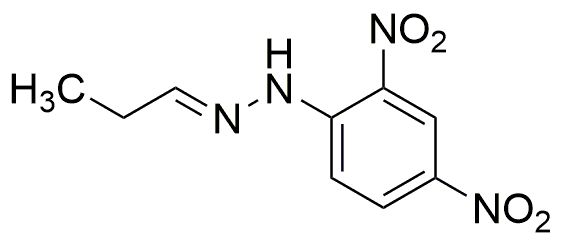Propionaldehyde-2,4-dinitrophenylhydrazone is widely utilized in research focused on:
- Hematology: This compound serves as a vital reagent in the identification and quantification of specific proteins in blood samples, aiding in the diagnosis of various blood disorders.
- Histology: It is commonly used in tissue staining protocols, enhancing the visualization of cellular structures under a microscope, which is essential for pathologists.
- Analytical Chemistry: The compound is employed in the development of analytical methods for detecting aldehydes, providing researchers with a reliable tool for environmental and food safety testing.
- Pharmaceutical Research: It plays a role in drug formulation studies, particularly in assessing the stability and reactivity of pharmaceutical compounds, which is crucial for developing effective medications.
- Biochemical Assays: This chemical is used in various biochemical assays to study enzyme activity and metabolic pathways, offering insights into cellular processes and potential therapeutic targets.
Información general
Propiedades
Seguridad y normativas
Aplicaciones
Propionaldehyde-2,4-dinitrophenylhydrazone is widely utilized in research focused on:
- Hematology: This compound serves as a vital reagent in the identification and quantification of specific proteins in blood samples, aiding in the diagnosis of various blood disorders.
- Histology: It is commonly used in tissue staining protocols, enhancing the visualization of cellular structures under a microscope, which is essential for pathologists.
- Analytical Chemistry: The compound is employed in the development of analytical methods for detecting aldehydes, providing researchers with a reliable tool for environmental and food safety testing.
- Pharmaceutical Research: It plays a role in drug formulation studies, particularly in assessing the stability and reactivity of pharmaceutical compounds, which is crucial for developing effective medications.
- Biochemical Assays: This chemical is used in various biochemical assays to study enzyme activity and metabolic pathways, offering insights into cellular processes and potential therapeutic targets.
Documentos
Hojas de datos de seguridad (HDS)
La SDS proporciona información de seguridad completa sobre la manipulación, el almacenamiento y la eliminación del producto.
Especificación del producto (PS)
La PS proporciona un desglose completo de las propiedades del producto, incluida la composición química, el estado físico, la pureza y los requisitos de almacenamiento. También detalla los rangos de calidad aceptables y las aplicaciones previstas del producto.
Certificados de análisis (COA)
Busque certificados de análisis (COA) ingresando el número de lote del producto. Los números de lote y de partida se pueden encontrar en la etiqueta de un producto después de las palabras "Lote" o "Lote".
Número de catálogo
Número de lote/lote
Certificados de origen (COO)
Este certificado de origen confirma el país en el que se fabricó el producto y también detalla los materiales y componentes utilizados en él y si se deriva de fuentes naturales, sintéticas u otras fuentes específicas. Este certificado puede ser necesario para cumplir con las normativas aduaneras, comerciales y regulatorias.
Número de catálogo
Número de lote/lote
Hojas de datos de seguridad (HDS)
La SDS proporciona información de seguridad completa sobre la manipulación, el almacenamiento y la eliminación del producto.
DownloadEspecificación del producto (PS)
La PS proporciona un desglose completo de las propiedades del producto, incluida la composición química, el estado físico, la pureza y los requisitos de almacenamiento. También detalla los rangos de calidad aceptables y las aplicaciones previstas del producto.
DownloadCertificados de análisis (COA)
Busque certificados de análisis (COA) ingresando el número de lote del producto. Los números de lote y de partida se pueden encontrar en la etiqueta de un producto después de las palabras "Lote" o "Lote".
Número de catálogo
Número de lote/lote
Certificados de origen (COO)
Este certificado de origen confirma el país en el que se fabricó el producto y también detalla los materiales y componentes utilizados en él y si se deriva de fuentes naturales, sintéticas u otras fuentes específicas. Este certificado puede ser necesario para cumplir con las normativas aduaneras, comerciales y regulatorias.

